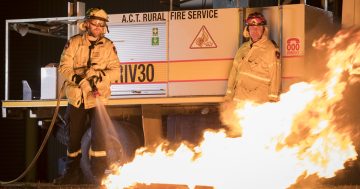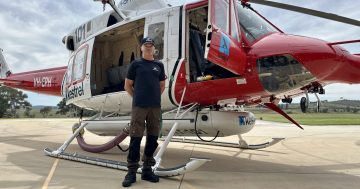
Multiple teams across the ACT Emergency Services Agency (ESA) are prepared for disasters this hazards season. Photo: Claire Fenwicke.
Recent bushfires on the South Coast and in Victoria, and yesterday’s storms across the ACT, signal a more intense hazards season for the entire Capital region this summer.
ACT Rural Fire Service chief officer Rohan Scott said the La Niña influence of the past three years means we’ve seen a more “complacent environment” with minimal bushfire activity and higher soil moisture profiles than we had heading into the 2019/2020 Black Summer season.
But this season will be different.
“We’re not entering this season with a drought deficient, but that soil moisture is actually encouraging grass growth, and we’re having some warm spring weather … what that means is that our grass will have some significant growth,” Mr Scott said.
“As we move into the heightened period with the summer season, the grass fuels are going to dry out and become available [for fires], so grass fires will be our greatest risk this year.”
Recent rain has given land management and fire crews another window to carry out further hazard reduction burns in the area, but that advantage could also flip and encourage further grass growth.
Due to the fast-moving nature of grassfires, the Canberra community has been urged to update or create a survival plan.
“Our next big season, unfortunately, if it’s not this year, it will be the year after or the year after that,” Mr Scott said.
“We can’t guarantee a truck in every corner, but we do ask the community to prepare with us and be ready for those incidents when they occur.
“Enact your survival plan before it is too late to keep yourself safe.”
After the New Year, the risk of forest fires will grow as their loads continue to dry out in the summer heat.
You shouldn’t just think of a survival plan for your home but also for those times you’re out in nature reserves and parks as fires can start no matter where you are.
“We can live with fire, we can remain safe, if you know what the fire danger index is, if you know what your survival plan is, and if you know what to do in the event of an incident,” Mr Scott said.
ACT Parks and Conservation Service workers have been carrying out prescribed burns and ensuring access to parks is available for vehicles if there is an emergency.
Parks Management senior director Justin Foley said more than 180 trained firefighters were ready to “hit the ground running”.
“We are ready, we are able and … the community should feel confident that we have managed fire fuels and risk in our parks appropriately,” he said.
Interim Emergency Services Agency (ESA) commissioner Wayne Phillips said all agencies had been preparing “tirelessly” to ensure they’re prepared and to minimise the impact of any emergency on the community.
However, they can’t do it alone.
“We need the help of the community to ensure that we’re better prepared for emergencies this year,” he said.
“Next chance you get: get ready, talk with your household about what you’ll do in an emergency, record [the plan] and prepare.
“Being prepared saves lives.”
The declared El Niño event for summer means Canberra will experience more heat, more wind and less rain towards Christmas.
But the Territory’s fire season also marks the start of the severe storm season.
The ACT State Emergency Service (SES) has seen 92 additional recruits join the volunteer list, but Chief Officer Anthony Draheim has also asked the community to prepare for the risk of storms or floods.
“Trim overhanging trees, know what to do in a storm or flood event and ensure you have an emergency plan, including a home emergency kit with supplies that will last for at least 72 hours,” he advised.
“You can help us by ensuring your home is prepared all year round for a storm.”
All Canberrans have been urged to be emergency ready this hazards season – be it for bushfires, storms, floods or fires in the home.




















